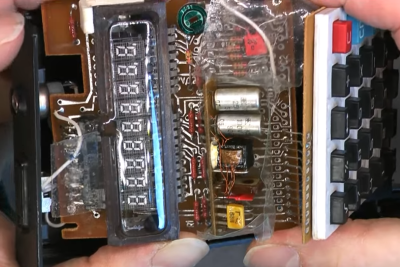Tearing down hardware from different parts of the world can be revealing, showing unique parts, techniques, and tricks employed by engineers living in a very different world from our own. To that end, [msylvain59] has been kind enough to give us a look inside the Elektronika MK-26—a calculator built in the former Soviet Union.
There’s lots of interesting stuff to see from the get-go. The oddball button pad is covered in Cyrillic symbols, quite alien to those of us more accustomed to the Latin character set. It’s also constructed somewhat unlike more familiar models from Western-aligned companies like Casio or Commodore. It also rattles when shaken, which doesn’t inspire confidence. Inside, it’s got old-school brown PCBs without the usual green solder mask, a chunky IC in a weird package, and display is via a power-hungry VFD.
 It doesn’t look so totally alien inside; much of the construction is pretty typical of the mid-1970s, wherever you went around the world. The most striking differences are more in the graphics and visual design than anything else.
It doesn’t look so totally alien inside; much of the construction is pretty typical of the mid-1970s, wherever you went around the world. The most striking differences are more in the graphics and visual design than anything else.
Ultimately, there are reasons why manufacturers around the world tend to converge on similar techniques. Generally, it’s because it’s more economical or easier to do things a certain way. And yet, we still see regional variances because conditions, technologies, and parts availability varies around the world. This teardown highlights that quite clearly.
If you’re just getting a taste for Soviet hardware teardowns, you’ll love this video diving inside a real Soyuz clock.
Continue reading “Soviet Calculator Teardown Reveals Similarities And Differences”

















